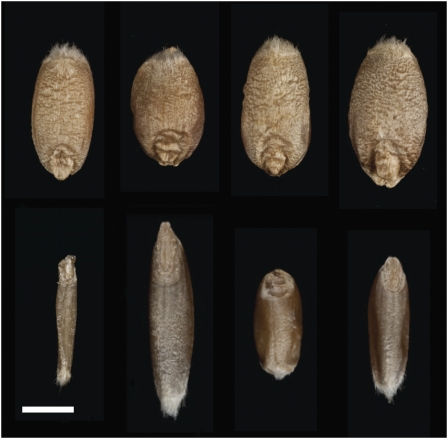The domestication of wheat around 10,000 years ago marked a dramatic turn in the development and evolution of human civilization, as it enabled the transition from a hunter-gatherer and nomadic pastoral society to a more sedentary agrarian one. Two of the most important traits in the evolution of bread wheat and other cultivated grasses were an increase in grain size and the development of nonshattering seed. The former has been associated with successful germination and growth of seedlings in cultivated fields, whereas the latter trait (a hallmark of domestication) prevents natural seed dispersal and allows humans to harvest and collect the seed with optimal timing (reviewed in Fuller, 2007; Purugganan and Fuller, 2009).
Gegas et al. (pages 1046–1056) provide insights into the evolution of domesticated wheat through large-scale morphometric and quantitative trait analyses of several recombinant doubled haploid populations of elite winter wheat and a comparison of grain material from primitive wheat species and modern elite varieties. They concluded that grain shape and size are independent traits in both modern varieties and primitive wheat species that are under the control of distinct genetic components.
The comprehensive analysis provides solid evidence that size and shape of grain are independently inherited traits and that wheat domestication resulted in a switch from production of a relatively small grain with a long, thin shape to a more uniform larger grain with a short, wide shape (see figure). These data illustrate the complex history of domesticated wheat evolution, suggesting that various traits (even some that are closely related) arose independently at different stages. For example, the authors suggest that grain size increased early in domestication through alterations both in grain width and length, followed at later stages by further modifications in grain shape largely through changes in grain length. In addition, the decrease in phenotypic diversity in grain morphology in modern commercial wheat is shown to be the result of a relatively recent and severe bottleneck that may have occurred either during the transition from hulled wheat to the modern nonhulled varieties or more recently during modern breeding programs.
Domestication of wheat led to changes in grain size, shape, and range of phenotypic variation. Grains are representative of modern elite varieties (top) and ancestral wheat species (bottom). (Adapted from Figures 1 and 4 of Gegas et al. [2010].)
The authors also conducted quantitative trait locus (QTL) analysis on six doubled haploid elite winter wheat populations. A large number of QTL with dispersed effects between the parents were identified and were consistent with independent inheritance of grain size and shape parameters. In addition, they examined the positional correspondence between QTL identified in wheat and known QTL or loci influencing grain morphology in rice and identified a number of potential orthologous loci.
This work constitutes a valuable addition to our knowledge of the evolution of domesticated wheat, with important implications for applied breeding of wheat toward improved yields and processing performance.
References
- Fuller D.Q. (2007). Contrasting patterns in crop domestication and domestication rates: recent archaeobotanical insights from the Old World. Ann. Bot. (Lond.) 100: 903–924 [DOI] [PMC free article] [PubMed] [Google Scholar]
- Gegas V.C., Nazari A., Griffiths S., Simmonds J., Fish L., Orford S., Sayers L., Doonan J.H., Snape J.W. (2010). A genetic framework for grain size and shape variation in wheat. Plant Cell 22: 1046–1056 [DOI] [PMC free article] [PubMed] [Google Scholar]
- Purugganan M.D., Fuller D.Q. (2009). The nature of selection during plant domestication. Nature 457: 843–848 [DOI] [PubMed] [Google Scholar]



